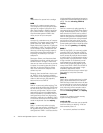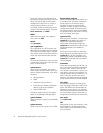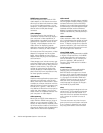
12 Dell PowerEdge 6300 Systems User’s Guide
4,&
Abbreviation for quarter-inch cartridge.
5$0
Acronym for random-access memory.
The computer’s primary temporary stor-
age area for program instructions and
data. Each location in RAM is identified
by a number called a
memory address
.
Any information stored in RAM is lost
when you turn off your computer.
5$,'
Acronym for redundant array of inexpen-
sive disks. This phrase was introduced by
David Patterson, Garth Gibson, and
Randy Katz at the University of California
at Berkeley in 1987. The goal of RAID is
to use multiple small, inexpensive disk
drives to provide high storage capacity
and performance while maintaining or
improving the reliability of the disk
subsystem.
Patterson, Gibson, and Katz described
five different methods, which are known
as RAID levels 1 through 5. Each level
uses one or more extra drives to provide
a means of recovering data lost when a
disk fails, so that the effective failure
rate of the whole disk subsystem be-
comes very low.
Recently, Katz has defined a sixth meth-
od, RAID 6, which improves reliability
even further, and a configuration that pro-
vides no data recovery has popularly
become known as RAID 0.
5$,'
RAID 0 is commonly called
striping
. This
was not originally defined as a RAID level
but has since come into popular use. In
this array configuration, data is written
sequentially across the available disks
and no redundancy is provided. RAID 0
configurations provide very high perfor-
mance but relatively low reliability. RAID
0 is the best choice when DSA controller
cards are duplexed. See also striping.
5$,'
RAID 1 is commonly called
mirroring
.
RAID 1 also uses striping, so RAID 1 may
be regarded as the mirroring of RAID 0
configurations. RAID 1 is the best choice
in high-availability applications that require
high performance or relatively low data ca-
pacity. See also mirroring, RAID 10,
striping.
5$,'
RAID 4 is commonly called
guarding
. It
uses data striping, like RAID 0, but adds a
single, dedicated parity drive. The parity
data stored on this drive can be used to
recover data lost from a single failed drive.
RAID 4 configurations write data slowly
because parity data has to be generated
and written to the parity drive, and the
generation of the parity data frequently re-
quires reading data from multiple physical
drives. See also guarding and striping.
5$,'
RAID 5, like RAID 4, is commonly called
guarding
. RAID 5 is identical to RAID 4,
except that the parity data is distributed
evenly across all physical drives instead
of a parity drive. In configurations using a
large number of physical drives in which
a large number of simultaneous small
write operations are being performed,
RAID 5 offers potentially higher perfor-
mance than RAID 4. RAID 4 and RAID 5
configurations are appropriate in high-
availability applications where
performance is less critical or where high
data capacity is required. See also
guarding.
5$,'
RAID 10 is a
mirroring
technique in which
data is duplicated across two identical
RAID 0 arrays or hard-disk drives. All data
on a physical drive in one array is duplicat-
ed, or
mirrored
, on a drive in the second
array. Mirroring offers complete redun-
dancy of data for greater data security.
See also mirroring, RAID 1, and striping.
5$0'$&
Acronym for random-access memory
digital-to-analog converter.
UHD GRQO\ILOH
A read-only file is one that you are prohib-
ited from editing or deleting. A file can
have read-only status if:
Its read-only attribute is enabled.


















